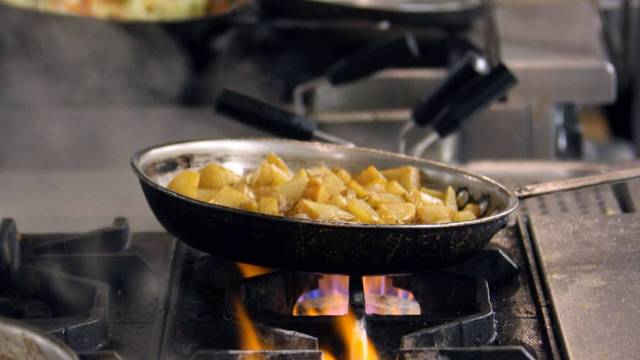Best Ambiance Restaurants Islamabad: Perfect Attractions for an Unforgettable Dish
Best Ambiance Restaurants Islamabad: Perfect Attractions for an Unforgettable Dish
Blog Article
Savor Authentic Oriental Food With a Pan-Asian Spin for a Cooking Journey
Beginning on a cooking journey with genuine Oriental food, improved with a Pan-Asian twist, supplies an one-of-a-kind possibility to discover the abundant tapestry of flavors that define the region's diverse culinary traditions. This experience welcomes you to savor the splendid equilibrium of tastes-- sweet, salty, spicy, and sour-- integrated by fragrant herbs and seasonings. Think of the cutting-edge fusion of Thai curry and ramen or the unforeseen joy of sushi burritos. As you contemplate these enticing meals, take into consideration the social narratives and historic impacts that shape them, each bite supplying a tale waiting to be uncovered.

Exploring Pan-Asian Flavors
In the world of worldwide gastronomy, Pan-Asian cuisine sticks out for its remarkable variety and the harmonious interplay of flavors from various Eastern cultures. This cooking approach celebrates the special components and rich practices located across the continent, developing a tapestry of tastes that is both interesting and rewarding. Key to Pan-Asian food is its capability to stabilize different tastes-- wonderful, salted, spicy, and sour-- while highlighting the freshness and high quality of each ingredient.
From the umami-rich soy sauce of Japan to the intense chili peppers of Thailand, Pan-Asian food uses a comprehensive scheme of tastes. These components are usually combined in innovative ways, improving meals with layers of complexity. For example, making use of fragrant natural herbs such as lemongrass and cilantro, typical in Vietnamese and Thai food, adds a refreshing brightness to dishes, while the incorporation of coconut milk delivers a velvety, rich texture.
The emphasis on fresh produce and aromatic spices makes certain that each dish is not only a feast for the taste buds yet also for the detects. Pan-Asian food invites restaurants to start a culinary trip, checking out the substantial and varied landscapes of Eastern gastronomy with every bite.
Combination Dishes to Attempt
While Pan-Asian food is celebrated for its typical tastes, the contemporary cooking landscape is progressively accepting combination meals that mix these traditional elements with influences from various other areas. This ingenious approach not just honors the abundant heritage of Eastern cookeries yet additionally presents novel taste experiences that interest contemporary tastes.
A prime instance of such a fusion dish is the Korean-Mexican taco, where marinated bulgogi beef is wrapped in a warm tortilla, covered with kimchi and a spicy gochujang-infused salsa. This combination weds the vibrant, savory flavors of Korea with the dynamic, fresh components of Mexican food. Similarly, sushi burritos have obtained popularity, joining together the delicate artistry of Japanese sushi with the hearty, hand-held ease of a burrito, typically including combination components like tempura shrimp and avocado with a drizzle of wasabi mayo.
One more notable recipe is Thai curry ramen, which infuses the luscious, fragrant spices of Thai curry right into the soothing brew of standard Japanese ramen, developing an unified blend that tantalizes the senses. These blend recipes prolong past simple novelty; they stand for a culinary discussion between cultures, motivating expedition and advancement in the globe of Pan-Asian food.
Crucial Components and Seasonings
To genuinely value Pan-Asian cuisine, one should recognize the important active ingredients and seasonings that form its foundation. This diverse culinary design draws from a rich tapestry of Oriental practices, using a harmonious mix of flavors and textures.
Fragrant elements are critical, with ginger, garlic, and lemongrass being ubiquitous across numerous Pan-Asian dishes. These active ingredients give a fragrant base that improves the intricacy of flavors. Spices such as star anise, cardamom, and cinnamon present warmth and personality, echoing influences from regions like China and India.

Food Preparation Techniques and Tips
Mastering the art of Pan-Asian cuisine needs familiarity with its distinctive cooking methods, each contributing to the lively tapestry of flavors this cooking tradition is commemorated for. Central to these techniques is the stir-fry, a quick food preparation strategy that preserves the dietary integrity and vivid shades of components. Making use Full Article of a frying pan, the stir-fry method enables also heat distribution, crucial for achieving the particular appearance and taste balance of Pan-Asian dishes.
An additional essential method is steaming, particularly prevalent in Chinese cuisine. This mild method preserves the all-natural flavors and nutrients of components, making it suitable for fish and shellfish and veggies. Dumplings, a beloved staple, frequently take advantage of steaming, resulting in soft, delicious textures.
Grilling, also important, presents smoky depths to meals such as Korean bulgogi or Japanese yakitori (Instagrammable restaurants Islamabad). This technique commonly includes marinating ingredients, enabling tastes to penetrate deeply before cooking over an open fire or warmer
Last but not least, understanding the art of balancing flavors-- wonderful, sour, salty, bitter, and umami-- is vital. Correctly layering these aspects can raise a meal from common to extraordinary, offering a complicated and satisfying cooking experience that symbolizes the significance of Pan-Asian food.
Dining Experiences Worldwide
Throughout the globe, Pan-Asian food uses an unparalleled eating experience, celebrated for its rich tapestry of tastes and vibrant presentations. This culinary phenomenon has transcended cultural borders, catching the hearts and tastes buds of food enthusiasts worldwide. In worldwide cities fresh York, London, and Sydney, Pan-Asian dining establishments act as melting pots where cooking customs from Thailand, Japan, China, and past assemble, giving restaurants with an eclectic mix of dishes that highlight the region's diversity.
The global charm of Pan-Asian cuisine depends on its ability to provide both authenticity and technology. Cooks skillfully wed standard components such as lemongrass, soy sauce, and miso with contemporary techniques, resulting in meals that are both refreshingly brand-new and familiar. This blend enables restaurants to begin on a cooking journey that appreciates heritage while embracing modernity.
Furthermore, dining experiences are elevated through thoughtfully developed settings that mirror the values of Pan-Asian appearances. From minimalist Japanese-inspired insides to vivid Thai-themed spaces, each dining establishment uses an unique ambiance that matches the why not try these out cooking offerings. Because of this, customers are not just taking in a meal yet partaking in a social experience, making Pan-Asian dining a really international sensation.
Conclusion
The exploration of Pan-Asian cuisine uses an extensive understanding of the intricate interplay of tastes and cooking practices throughout Asia. By embracing combination meals such as Thai curry ramen and sushi burritos, the culinary journey not just highlights the adaptability of traditional components yet additionally showcases cutting-edge modern strategies. This gastronomic journey, enhanced by important flavors and cooking techniques, gives a distinct possibility to appreciate the cultural variety and cooking artistry that define Pan-Asian cuisine on an international range.
Embarking on a cooking trip with genuine Asian cuisine, boosted with a Pan-Asian spin, provides american food near me a special possibility to explore the rich tapestry of tastes that specify the region's diverse culinary customs.In the realm of worldwide gastronomy, Pan-Asian cuisine stands out for its impressive diversity and the harmonious interaction of tastes from numerous Oriental cultures. Secret to Pan-Asian food is its ability to balance contrasting tastes-- pleasant, salted, spicy, and sour-- while highlighting the freshness and quality of each ingredient.

Report this page